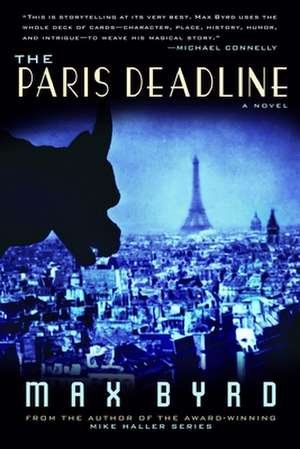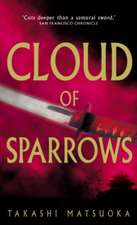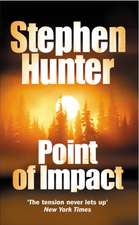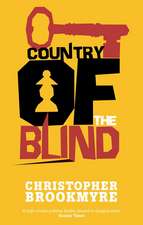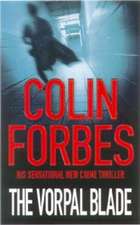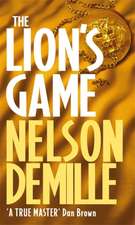The Paris Deadline
Autor Max Byrden Limba Engleză Hardback – 15 oct 2012
From bestselling historical novelist Max Byrd comes a new novel set against the dramatic backdrop of Paris in the Jazz Age—a fascinating suspense tale interwoven with rich historical detail.
Paris, 1926. Newspaper reporter Toby Keats, a veteran of the Great War and the only American in Paris who doesn’t know Hemingway, has lived a quiet life—until one day he comes into possession of a rare eighteenth-century automate, a very strange and somewhat scandalous mechanical duck. Highly sought after by an enigmatic American banker, European criminals, and the charming young American Elsie Short, the duck is rumored to hold the key to opening a new frontier in weapons technology for the German army, now beginning to threaten Europe once more. Haunted with his nightmarish past in the War, Toby pursues the truth behind the duck.
From the boites of the Left Bank to the dark prehistoric caverns of southern France, The Paris Deadline is a story of love, suspense, and mystery in a world stumbling toward catastrophe.
Paris, 1926. Newspaper reporter Toby Keats, a veteran of the Great War and the only American in Paris who doesn’t know Hemingway, has lived a quiet life—until one day he comes into possession of a rare eighteenth-century automate, a very strange and somewhat scandalous mechanical duck. Highly sought after by an enigmatic American banker, European criminals, and the charming young American Elsie Short, the duck is rumored to hold the key to opening a new frontier in weapons technology for the German army, now beginning to threaten Europe once more. Haunted with his nightmarish past in the War, Toby pursues the truth behind the duck.
From the boites of the Left Bank to the dark prehistoric caverns of southern France, The Paris Deadline is a story of love, suspense, and mystery in a world stumbling toward catastrophe.
| Toate formatele și edițiile | Preț | Express |
|---|---|---|
| Paperback (1) | 102.26 lei 3-5 săpt. | |
| Turner – 7 oct 2013 | 102.26 lei 3-5 săpt. | |
| Hardback (1) | 207.41 lei 3-5 săpt. | |
| Turner – 15 oct 2012 | 207.41 lei 3-5 săpt. |
Preț: 207.41 lei
Nou
Puncte Express: 311
Preț estimativ în valută:
39.69€ • 41.52$ • 32.97£
39.69€ • 41.52$ • 32.97£
Carte disponibilă
Livrare economică 12-26 martie
Preluare comenzi: 021 569.72.76
Specificații
ISBN-13: 9781618580122
ISBN-10: 1618580124
Pagini: 328
Dimensiuni: 161 x 237 x 31 mm
Greutate: 0.63 kg
Editura: Turner
ISBN-10: 1618580124
Pagini: 328
Dimensiuni: 161 x 237 x 31 mm
Greutate: 0.63 kg
Editura: Turner
Recenzii
From Publishers Weekly:
Byrd’s standalone blends humor and suspense well. It’s Paris, 1926 and Toby Keats, a master tunneler for the US Army during WWI, is now a reporter for the Chicago Tribune; his prosaic existence becomes anything but when he’s assigned to help the paper’s Queen Mother, Katherine Van Etta Medill McCormick, who routinely used him to run errands for her when visiting Paris. Having paid for two “splendid South American automatic parrots,” she’s upset to have a dingy mechanical duck delivered to her instead. The duck may be more valuable than it appeared—Keats learns that it may be the legendary Vaucanson’s defecating duck reported to have eaten “food with its beak, digested it, and...excreted it.” Things ramp up in complexity when an attractive woman, Elsie Short, claims that the duck is hers, and Keats’s pursuit of the truth enmeshes him in murder. Fans of The Maltese Falcon open to a funny riff on its plot will be delighted. —Cevin Bryerman
Named one of 2012's 10 Best Crime Novels by Kirkus
From Kirkus Reviews:
Every reader has his or her own appetite for detail in historical fiction. Personally, I tend toward gluttony. Give me a wordy but wholly verisimilitudinous re-creation of some city of yore, a forgotten rural landscape or an archaic industrial enterprise, and I shall gleefully dine upon it page after glorious page. I do have my limits, and some novels manage to exceed it; Elizabeth Kostova’s The Historian comes immediately to mind. However, I can be very forgiving of an author’s earnest efforts to transport me, through the supple vehicle of English expression, into a period, place and culture that’s not otherwise accessible.
So don’t bother repeating to me the complaints, leveled by some other critics, that Max Byrd’s effervescent new historical mystery, The Paris Deadline, overburdens readers with street and alley monikers, and threatens their patience with its meticulous descriptions of early 20th-century railroad travel or the French capital’s once-intricate pneumatic-tube communications system. Far from implying that Byrd was overly fond of his research and intent on proving his scholarship, these particulars add authenticity, significance and essential grounding to a plot that often threatens to spin free of credibility’s fragile bounds.
Consider this evocative portrayal of the Chicago Tribune’s French bureau in 1926, where a young rewrite man named Toby Keats plies his lowly trade:
The Paris edition of the Tribune occupied the top three floors of a rambling nineteenth-century structure that had not been designed with modern journalism in mind. Apart from the Managing Editor’s sanctum behind a frosted glass door, our editorial offices consisted of one long city room, which held a collection of sprung leather chairs, a long oval table covered with typewriters and ashtrays, and a string of smaller rewrite desks like ours, crammed off to the side and in the corners. All practically deserted, of course, at this time of the morning. Bedlam arrived later, with the regular reporters, at the civilized hour of noon.
New Mexico born and Harvard educated, Keats volunteered for the Third Army Engineers during the so-called Great War, only to wind up excavating tunnels through enemy territory—an assignment that left him so traumatized, he now won’t even descend into Paris’ bustling web of subways. Since the war’s finish, he’s carved out a less perilous existence for himself in the City of Light, drinking his body weight in coffee, dodging herds of goats in the cobblestone thoroughfares, and observing both the reluctant begging habits of disfigured ex-soldiers and the fashions of local officials. (“In those years Parisian gendarmes still wore black silk-lined capes in the winter. The slang term for policemen then was hirondelles—swallows—because as they went down the dark streets on bicycles, the capes rose and flapped behind them like tails and they looked like swooping birds. To me they looked like bats.”)
In The Paris Deadline, it falls to Keats to return a dilapidated, life-size and automated antique duck that was mistakenly sent to the spendthrift mother of the Tribune’s publisher, Colonel Robert McCormick. It seems the woman had ordered “two absolutely marvelous” mechanical parrots from a tiny shop on the rue Bonaparte, but instead received this “moth-eaten” quacker. She wants Keats to exchange it for her actual purchases.
However, the shop owner soon turns up dead, and Keats is beaten in the street before being approached by a charming and resourceful young blonde named Elsie Short, who—after attempting to misrepresent her interest in the robotic waterfowl—finally admits to be a “roving agent” for the Thomas Edison Doll Company.
Elsie claims she wants the creature only as a historical curiosity. But could this be yet another ruse? After all, the ersatz bird in Keats’ hands looks an awful lot like Vaucanson’s Duck, a “somewhat scandalous” 18th-century automaton. The original beast, created by French inventor Jacques de Vaucanson, boasted some 400 moving parts and could not only flap its wings, but appear to eat and digest grain. Although Vaucanson’s Duck was supposedly “destroyed in a fire” more than a century before, Keats has doubts about that record. Which are only exacerbated as it becomes clear that parties of various nefarious stripes desire the duck for themselves, including an American banker and criminals who may covet the automaton for its operating mechanism—technology that might serve to advance weapons development.
Only when Elsie Short is kidnapped and whisked off to Switzerland, though, does Keats comprehend that his shabby duck is the key to a larger puzzle involving secret codes, hidden messages and what may be a long-buried fortune.
Author Byrd won a Shamus Award from the Private Eye Writers of America for California Thriller (1981), the first in a trio of novels starring San Francisco gumshoe Mike Haller. During the 1990s he penned historical fiction about a trio of U.S. presidents: Thomas Jefferson, Andrew Jackson and Ulysses S. Grant. Now, in The Paris Deadline, he delivers a sparkling and suspenseful caper adventure well-rooted in a lovingly re-animated Jazz Age Paris.
Yes, Byrd can be a bit melodramatic with some plot turns, and he leaves at least one mystery oddly dangling at the book’s end. But he nicely avoids recruiting Ernest Hemingway into this story (a feat other novelists writing about 1920s Paris frequently fail to match), instead employing, at Keats’ side, two other real-life figures who labored in the Tribune’s French outpost at that time: William L. Shirer, who’d later compose The Rise and Fall of the Third Reich; and Waverly Root, who became famous for his food writing, but in The Paris Deadline is heralded for his rewriting talents:
... [I]n those days the [Tribune’s] Paris edition was normally eight to ten pages long, much of it sports scores and stock market numbers. For home news, to save money, the Colonel limited our incoming cables to fifty words a night. The result was that often we were presented with a stingy four-word summary from Chicago (“Pres speaks Protestant Conv”) and expected to spin out a full six-inch story from that. Root was a gifted and uninhibited spinner, especially good at political vacuousness, and his more exuberant inventions were occasionally picked up and reprinted by the wire services, to the mild confusion of those who actually witnessed an event.
It’s those sorts of incidental details, together with Byrd’s bursts of jocular prose, that make me hope we haven’t seen the last of Toby Keats.
—J. Kingston Pierce
"Anyone fascinated by automates will enjoy Max Byrd’s new thriller . . . it reminds us of a time when complex and delicate automates spoke vividly of the human power of invention." —Alan Riding, New York Times Book Review
"A mechanical duck takes a star turn, keeping us not just entertained but rapt . . . in Max Byrd’s deeply gratifying historical fiction The Paris Deadline." —Peter Lewis, Barnes and Noble Review
“Max Byrd is an expert at mingling real historical figures with his invented characters.” —The New York Times
“Wow! This is storytelling at its very best. Max Byrd uses the whole deck of cards—character, place, history, humor, and intrigue—to weave his magical story. You want a good ride? The Paris Deadline is your ticket!” —Michael Connelly, New York Times bestselling author of The Brass Verdict and The Scarecrow
“The Paris Deadline is the best ‘code and cipher’ novel I’ve ever read, a wonderful historical thriller, combining terrific characters with wit, erudition, more cool facts than your average encyclopedia, and a blistering narrative drive that makes the pages fly. Do not deny yourself the pleasure of reading this book!” —John Lescroart, author of The Thirteenth Juror and Betrayal
“Some of the things I love most about the book—the wit and erudition, the scholarship, the interesting things about the underground war and automates—are not the things other people will like. They’ll be caught up in the mystery of the duck and the love story between the appealing Toby and Elsie, and the fact that it’s set in Paris. Of course, I love that too!” —Diane Johnson, author of Le Divorce and The Shadow Knows
Byrd’s standalone blends humor and suspense well. It’s Paris, 1926 and Toby Keats, a master tunneler for the US Army during WWI, is now a reporter for the Chicago Tribune; his prosaic existence becomes anything but when he’s assigned to help the paper’s Queen Mother, Katherine Van Etta Medill McCormick, who routinely used him to run errands for her when visiting Paris. Having paid for two “splendid South American automatic parrots,” she’s upset to have a dingy mechanical duck delivered to her instead. The duck may be more valuable than it appeared—Keats learns that it may be the legendary Vaucanson’s defecating duck reported to have eaten “food with its beak, digested it, and...excreted it.” Things ramp up in complexity when an attractive woman, Elsie Short, claims that the duck is hers, and Keats’s pursuit of the truth enmeshes him in murder. Fans of The Maltese Falcon open to a funny riff on its plot will be delighted. —Cevin Bryerman
Named one of 2012's 10 Best Crime Novels by Kirkus
From Kirkus Reviews:
Every reader has his or her own appetite for detail in historical fiction. Personally, I tend toward gluttony. Give me a wordy but wholly verisimilitudinous re-creation of some city of yore, a forgotten rural landscape or an archaic industrial enterprise, and I shall gleefully dine upon it page after glorious page. I do have my limits, and some novels manage to exceed it; Elizabeth Kostova’s The Historian comes immediately to mind. However, I can be very forgiving of an author’s earnest efforts to transport me, through the supple vehicle of English expression, into a period, place and culture that’s not otherwise accessible.
So don’t bother repeating to me the complaints, leveled by some other critics, that Max Byrd’s effervescent new historical mystery, The Paris Deadline, overburdens readers with street and alley monikers, and threatens their patience with its meticulous descriptions of early 20th-century railroad travel or the French capital’s once-intricate pneumatic-tube communications system. Far from implying that Byrd was overly fond of his research and intent on proving his scholarship, these particulars add authenticity, significance and essential grounding to a plot that often threatens to spin free of credibility’s fragile bounds.
Consider this evocative portrayal of the Chicago Tribune’s French bureau in 1926, where a young rewrite man named Toby Keats plies his lowly trade:
The Paris edition of the Tribune occupied the top three floors of a rambling nineteenth-century structure that had not been designed with modern journalism in mind. Apart from the Managing Editor’s sanctum behind a frosted glass door, our editorial offices consisted of one long city room, which held a collection of sprung leather chairs, a long oval table covered with typewriters and ashtrays, and a string of smaller rewrite desks like ours, crammed off to the side and in the corners. All practically deserted, of course, at this time of the morning. Bedlam arrived later, with the regular reporters, at the civilized hour of noon.
New Mexico born and Harvard educated, Keats volunteered for the Third Army Engineers during the so-called Great War, only to wind up excavating tunnels through enemy territory—an assignment that left him so traumatized, he now won’t even descend into Paris’ bustling web of subways. Since the war’s finish, he’s carved out a less perilous existence for himself in the City of Light, drinking his body weight in coffee, dodging herds of goats in the cobblestone thoroughfares, and observing both the reluctant begging habits of disfigured ex-soldiers and the fashions of local officials. (“In those years Parisian gendarmes still wore black silk-lined capes in the winter. The slang term for policemen then was hirondelles—swallows—because as they went down the dark streets on bicycles, the capes rose and flapped behind them like tails and they looked like swooping birds. To me they looked like bats.”)
In The Paris Deadline, it falls to Keats to return a dilapidated, life-size and automated antique duck that was mistakenly sent to the spendthrift mother of the Tribune’s publisher, Colonel Robert McCormick. It seems the woman had ordered “two absolutely marvelous” mechanical parrots from a tiny shop on the rue Bonaparte, but instead received this “moth-eaten” quacker. She wants Keats to exchange it for her actual purchases.
However, the shop owner soon turns up dead, and Keats is beaten in the street before being approached by a charming and resourceful young blonde named Elsie Short, who—after attempting to misrepresent her interest in the robotic waterfowl—finally admits to be a “roving agent” for the Thomas Edison Doll Company.
Elsie claims she wants the creature only as a historical curiosity. But could this be yet another ruse? After all, the ersatz bird in Keats’ hands looks an awful lot like Vaucanson’s Duck, a “somewhat scandalous” 18th-century automaton. The original beast, created by French inventor Jacques de Vaucanson, boasted some 400 moving parts and could not only flap its wings, but appear to eat and digest grain. Although Vaucanson’s Duck was supposedly “destroyed in a fire” more than a century before, Keats has doubts about that record. Which are only exacerbated as it becomes clear that parties of various nefarious stripes desire the duck for themselves, including an American banker and criminals who may covet the automaton for its operating mechanism—technology that might serve to advance weapons development.
Only when Elsie Short is kidnapped and whisked off to Switzerland, though, does Keats comprehend that his shabby duck is the key to a larger puzzle involving secret codes, hidden messages and what may be a long-buried fortune.
Author Byrd won a Shamus Award from the Private Eye Writers of America for California Thriller (1981), the first in a trio of novels starring San Francisco gumshoe Mike Haller. During the 1990s he penned historical fiction about a trio of U.S. presidents: Thomas Jefferson, Andrew Jackson and Ulysses S. Grant. Now, in The Paris Deadline, he delivers a sparkling and suspenseful caper adventure well-rooted in a lovingly re-animated Jazz Age Paris.
Yes, Byrd can be a bit melodramatic with some plot turns, and he leaves at least one mystery oddly dangling at the book’s end. But he nicely avoids recruiting Ernest Hemingway into this story (a feat other novelists writing about 1920s Paris frequently fail to match), instead employing, at Keats’ side, two other real-life figures who labored in the Tribune’s French outpost at that time: William L. Shirer, who’d later compose The Rise and Fall of the Third Reich; and Waverly Root, who became famous for his food writing, but in The Paris Deadline is heralded for his rewriting talents:
... [I]n those days the [Tribune’s] Paris edition was normally eight to ten pages long, much of it sports scores and stock market numbers. For home news, to save money, the Colonel limited our incoming cables to fifty words a night. The result was that often we were presented with a stingy four-word summary from Chicago (“Pres speaks Protestant Conv”) and expected to spin out a full six-inch story from that. Root was a gifted and uninhibited spinner, especially good at political vacuousness, and his more exuberant inventions were occasionally picked up and reprinted by the wire services, to the mild confusion of those who actually witnessed an event.
It’s those sorts of incidental details, together with Byrd’s bursts of jocular prose, that make me hope we haven’t seen the last of Toby Keats.
—J. Kingston Pierce
"Anyone fascinated by automates will enjoy Max Byrd’s new thriller . . . it reminds us of a time when complex and delicate automates spoke vividly of the human power of invention." —Alan Riding, New York Times Book Review
"A mechanical duck takes a star turn, keeping us not just entertained but rapt . . . in Max Byrd’s deeply gratifying historical fiction The Paris Deadline." —Peter Lewis, Barnes and Noble Review
“Max Byrd is an expert at mingling real historical figures with his invented characters.” —The New York Times
“Wow! This is storytelling at its very best. Max Byrd uses the whole deck of cards—character, place, history, humor, and intrigue—to weave his magical story. You want a good ride? The Paris Deadline is your ticket!” —Michael Connelly, New York Times bestselling author of The Brass Verdict and The Scarecrow
“The Paris Deadline is the best ‘code and cipher’ novel I’ve ever read, a wonderful historical thriller, combining terrific characters with wit, erudition, more cool facts than your average encyclopedia, and a blistering narrative drive that makes the pages fly. Do not deny yourself the pleasure of reading this book!” —John Lescroart, author of The Thirteenth Juror and Betrayal
“Some of the things I love most about the book—the wit and erudition, the scholarship, the interesting things about the underground war and automates—are not the things other people will like. They’ll be caught up in the mystery of the duck and the love story between the appealing Toby and Elsie, and the fact that it’s set in Paris. Of course, I love that too!” —Diane Johnson, author of Le Divorce and The Shadow Knows
"Byrd offers up an alternately sparkling and suspenseful yarn with a mystery plot rooted amidst a loving re-creation of post-World War I Parisian life. Highly recommended." —Pierce's Picks, The Rap Sheet
"Fans will enjoy Max Byrd’s exhilarating ode to Paris between the wars." —The Mystery Gazette
"Byrd evokes 1920's Paris so successfully that at times I felt like I was reading an unpublished chapter of Hemingway's A MOVEABLE FEAST . . . The story is engaging, the characters charming. The mystery at the heart of the book compelling (after all, it's about a two century old toy duck, of all things!)." —Brian Thornton, SleuthSayers.com
"Fans will enjoy Max Byrd’s exhilarating ode to Paris between the wars." —The Mystery Gazette
"Byrd evokes 1920's Paris so successfully that at times I felt like I was reading an unpublished chapter of Hemingway's A MOVEABLE FEAST . . . The story is engaging, the characters charming. The mystery at the heart of the book compelling (after all, it's about a two century old toy duck, of all things!)." —Brian Thornton, SleuthSayers.com
Notă biografică
Max Byrd is the award-winning author of fourteen books, including four bestselling historical novels and California Thriller, for which he received the Shamus Award. He was educated at Harvard and King’s College Cambridge, England, and has taught at Yale, Stanford, and the University of California. Byrd is a Contributing Editor of The Wilson Quarterly and writes regularly for the New York Times Book Review. He lives in California.
Extras
I was living in a one-room garret, a fourth-floor walk-up not much wider than a coat hanger, on the disreputable rue du Dragon in the 6th arrondissement.
And no, to get the question out of the way at once, I didn’t know Hemingway, though it was Paris and the year was 1926 and every other expatriate American in the city seemed to trip over his feet or lend him money as a daily occurrence. (Years later I did stand behind him in the mail line at American Express and listened to him denounce Woodrow Wilson in very loud and Hemingwayesque French, which had the slow, clear, menacing cadence of a bull’s hoof pawing the ground.)
The only literary person I actually did know, besides Gertrude Stein’s landlord, was the journalist who sat on the other side of the desk we shared at the Chicago Tribune offices on the rue Lamartine.
This was a slender, amiable young man named Waverley Root. He was twenty-six that year, the same as the century, five years younger than I was and therefore not quite old enough to have been in the war. Root was a remarkable person who wrote English like a puckish angel and spoke French as if he had a mouthful of cheese, and a decade or so later he was to find his true calling as a celebrated food critic for the New York Herald. The last time I saw him he wore nothing but yellow shirts and had gotten so fat he appeared to have inflated himself in one push of a button, like a rubber raft on a ship.
But in those days celebrity was far over the horizon, and Waverley Root was simply another vagabond reporter who had washed up on the cobblestoned shores of the rue Lamartine in search of a job. He had gone to Tufts. I had gone to Harvard. He had worked for the New York World. I had worked for the Boston Globe. He drank anisette, and I drank Scotch, and this small divergence in personal character accounted for the fact that on the chilly, rainy Monday morning of December 7, he was leaning against my chair, nursing a French hangover (as he nicely put it) rigid, classical, and comprehensive.
"Toby,” he said, “I will never drink alcohol again.”
“I know it.”
“An owl slept in my mouth last night. My teeth turned green. My poor eyes look like two bags of blood.”
“They look like two bags of ink.” I typed “30”—newspaperese for “The End”—on a sheet of yellow paper and swiveled to hand it, literally, through a hole in the wall.
The Paris edition of the Tribune occupied the top three floors of a rambling nineteenth-century structure that had not been designed with modern journalism in mind. Apart from the Managing Editor’s sanctum behind a frosted glass door, our editorial offices consisted of one long City Room, which held a collection of sprung leather chairs, a long oval table covered with typewriters and ashtrays, and a string of smaller rewrite desks like ours, crammed off to the sides and in the corners. All practically deserted, of course, at this time of the morning. Bedlam arrived later, with the regular reporters, at the civilized hour of noon.
The composing rooms were downstairs (we lowered copy by force of gravity, through a chute in the middle of the floor) and the printing presses were in the basement. Our copyeditors had been banished to an interior room mysteriously inaccessible to us except by going down two flights of stairs and up again three, hence the hole in the wall. More than one visitor, seeing a disembodied hand waving vaguely through a slot in the plaster, had been put in mind of the House of Usher.
“And there is no health in me,” Root said and sat down heavily on his side of the desk.
“It’s nine thirty-one,” I said. “She told us to be there at ten.”
Our urchinish French copy boy plopped a thick stack of rubber composing mats on my blotter, murmured “Mon cher Papa,” as he did every morning, and sidled away, smoking a torpedo sized Gitane, to the dark little basement cubby he inhabited down among the rolls of newsprint. He called me “Old Dad” because even at thirty-one, my hair was mostly silver-gray, almost white, like a policeman’s helmet. Many people, especially women, assumed sympathetically that something had turned it that way in the war, and if they were young and attractive, I had been known not to correct them. In fact, it had simply happened overnight when I was nineteen, and for some obscure reason, possibly modesty, probably vanity, I had never tried to dye it.
And no, to get the question out of the way at once, I didn’t know Hemingway, though it was Paris and the year was 1926 and every other expatriate American in the city seemed to trip over his feet or lend him money as a daily occurrence. (Years later I did stand behind him in the mail line at American Express and listened to him denounce Woodrow Wilson in very loud and Hemingwayesque French, which had the slow, clear, menacing cadence of a bull’s hoof pawing the ground.)
The only literary person I actually did know, besides Gertrude Stein’s landlord, was the journalist who sat on the other side of the desk we shared at the Chicago Tribune offices on the rue Lamartine.
This was a slender, amiable young man named Waverley Root. He was twenty-six that year, the same as the century, five years younger than I was and therefore not quite old enough to have been in the war. Root was a remarkable person who wrote English like a puckish angel and spoke French as if he had a mouthful of cheese, and a decade or so later he was to find his true calling as a celebrated food critic for the New York Herald. The last time I saw him he wore nothing but yellow shirts and had gotten so fat he appeared to have inflated himself in one push of a button, like a rubber raft on a ship.
But in those days celebrity was far over the horizon, and Waverley Root was simply another vagabond reporter who had washed up on the cobblestoned shores of the rue Lamartine in search of a job. He had gone to Tufts. I had gone to Harvard. He had worked for the New York World. I had worked for the Boston Globe. He drank anisette, and I drank Scotch, and this small divergence in personal character accounted for the fact that on the chilly, rainy Monday morning of December 7, he was leaning against my chair, nursing a French hangover (as he nicely put it) rigid, classical, and comprehensive.
"Toby,” he said, “I will never drink alcohol again.”
“I know it.”
“An owl slept in my mouth last night. My teeth turned green. My poor eyes look like two bags of blood.”
“They look like two bags of ink.” I typed “30”—newspaperese for “The End”—on a sheet of yellow paper and swiveled to hand it, literally, through a hole in the wall.
The Paris edition of the Tribune occupied the top three floors of a rambling nineteenth-century structure that had not been designed with modern journalism in mind. Apart from the Managing Editor’s sanctum behind a frosted glass door, our editorial offices consisted of one long City Room, which held a collection of sprung leather chairs, a long oval table covered with typewriters and ashtrays, and a string of smaller rewrite desks like ours, crammed off to the sides and in the corners. All practically deserted, of course, at this time of the morning. Bedlam arrived later, with the regular reporters, at the civilized hour of noon.
The composing rooms were downstairs (we lowered copy by force of gravity, through a chute in the middle of the floor) and the printing presses were in the basement. Our copyeditors had been banished to an interior room mysteriously inaccessible to us except by going down two flights of stairs and up again three, hence the hole in the wall. More than one visitor, seeing a disembodied hand waving vaguely through a slot in the plaster, had been put in mind of the House of Usher.
“And there is no health in me,” Root said and sat down heavily on his side of the desk.
“It’s nine thirty-one,” I said. “She told us to be there at ten.”
Our urchinish French copy boy plopped a thick stack of rubber composing mats on my blotter, murmured “Mon cher Papa,” as he did every morning, and sidled away, smoking a torpedo sized Gitane, to the dark little basement cubby he inhabited down among the rolls of newsprint. He called me “Old Dad” because even at thirty-one, my hair was mostly silver-gray, almost white, like a policeman’s helmet. Many people, especially women, assumed sympathetically that something had turned it that way in the war, and if they were young and attractive, I had been known not to correct them. In fact, it had simply happened overnight when I was nineteen, and for some obscure reason, possibly modesty, probably vanity, I had never tried to dye it.
Descriere
From bestselling historical novelist Max Byrd comes a new novel set against the dramatic backdrop of Paris in the Jazz Age—a fascinating suspense tale interwoven with rich historical detail.
Paris, 1926. Newspaper reporter Toby Keats, a veteran of the Great War and the only American in Paris who doesn’t know Hemingway, has lived a quiet life—until one day he comes into possession of a rare eighteenth-century automate, a very strange and somewhat scandalous mechanical duck. Highly sought after by an enigmatic American banker, European criminals, and the charming young American Elsie Short, the duck is rumored to hold the key to opening a new frontier in weapons technology for the German army, now beginning to threaten Europe once more. Haunted with his nightmarish past in the War, Toby pursues the truth behind the duck.
From the boites of the Left Bank to the dark prehistoric caverns of southern France, The Paris Deadline is a story of love, suspense, and mystery in a world stumbling toward catastrophe.
Paris, 1926. Newspaper reporter Toby Keats, a veteran of the Great War and the only American in Paris who doesn’t know Hemingway, has lived a quiet life—until one day he comes into possession of a rare eighteenth-century automate, a very strange and somewhat scandalous mechanical duck. Highly sought after by an enigmatic American banker, European criminals, and the charming young American Elsie Short, the duck is rumored to hold the key to opening a new frontier in weapons technology for the German army, now beginning to threaten Europe once more. Haunted with his nightmarish past in the War, Toby pursues the truth behind the duck.
From the boites of the Left Bank to the dark prehistoric caverns of southern France, The Paris Deadline is a story of love, suspense, and mystery in a world stumbling toward catastrophe.
